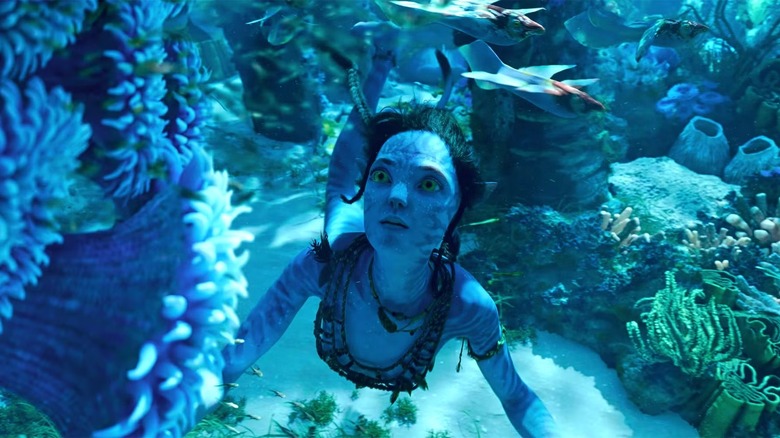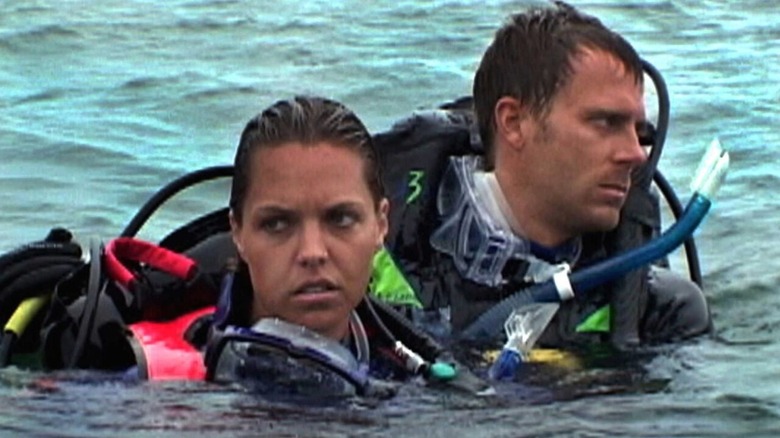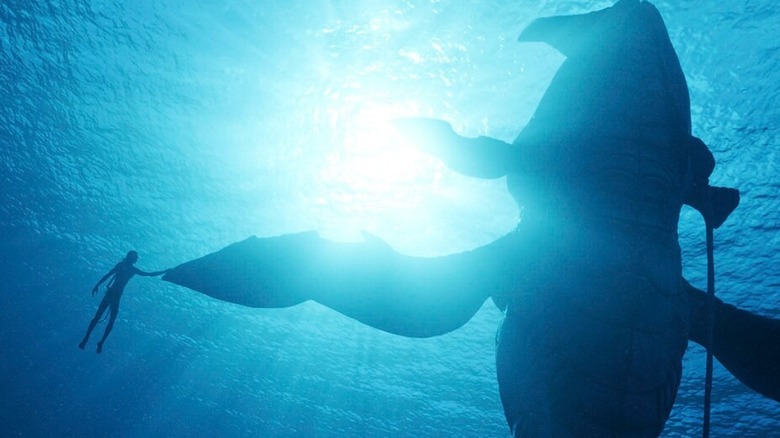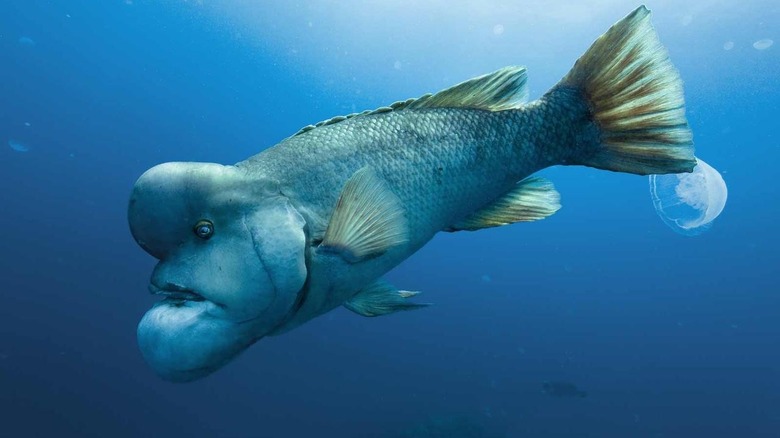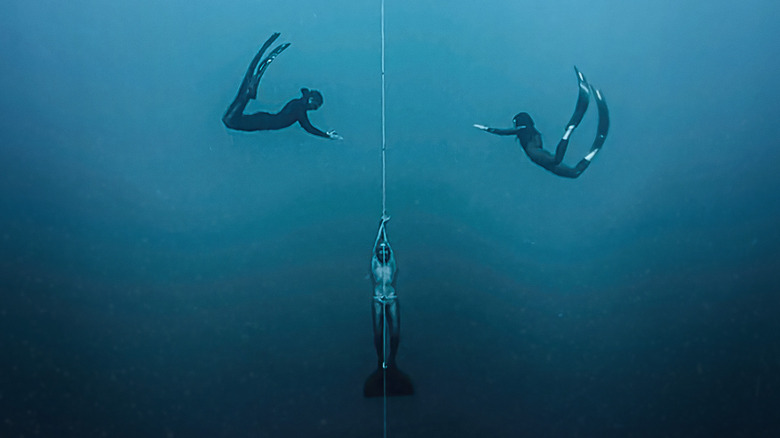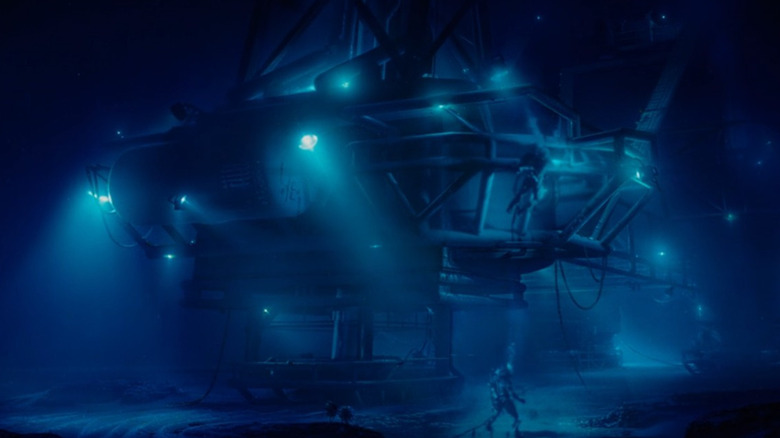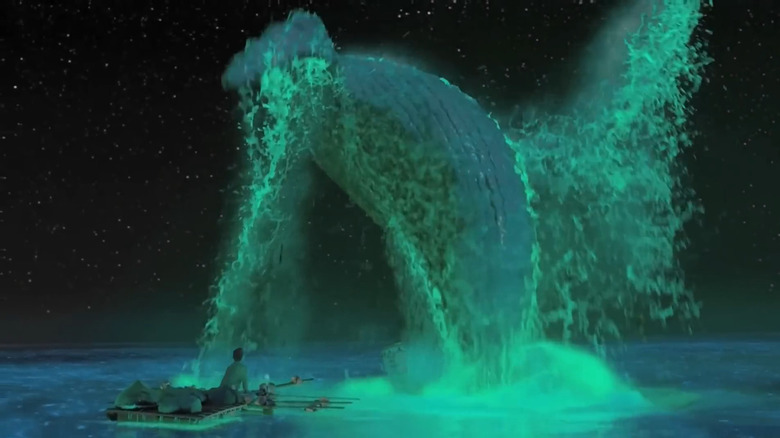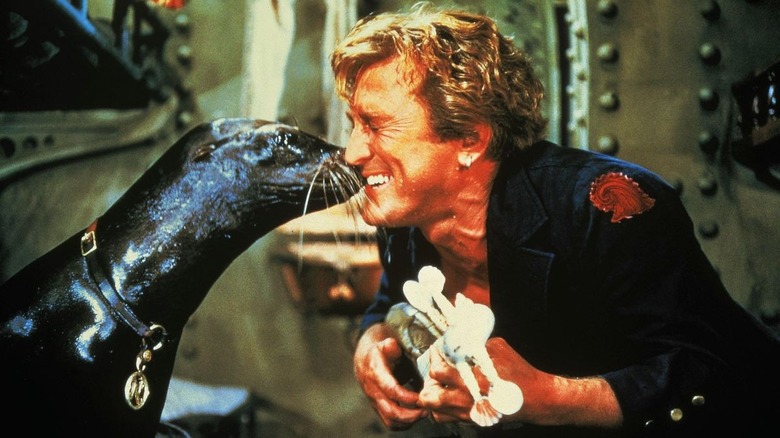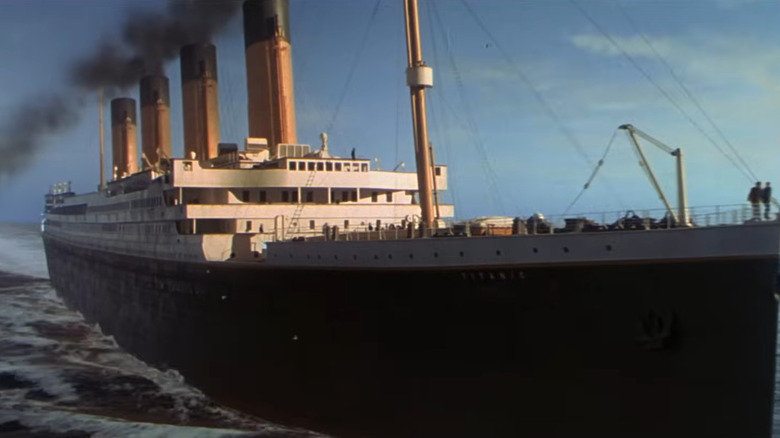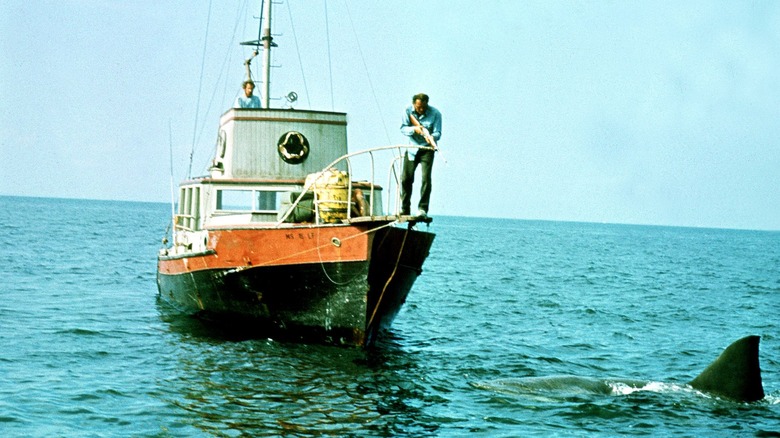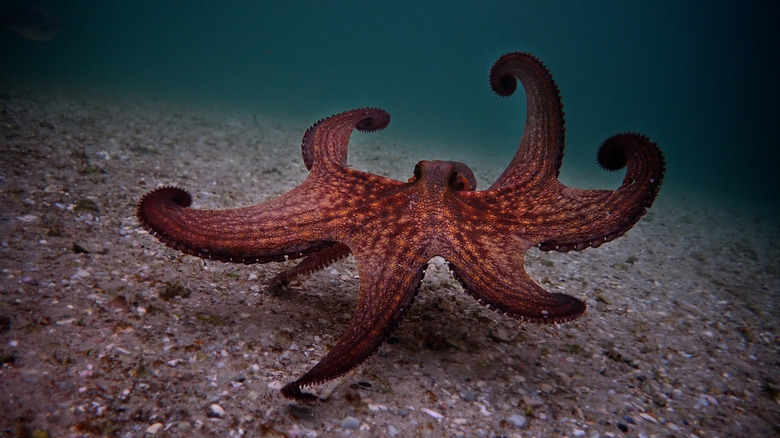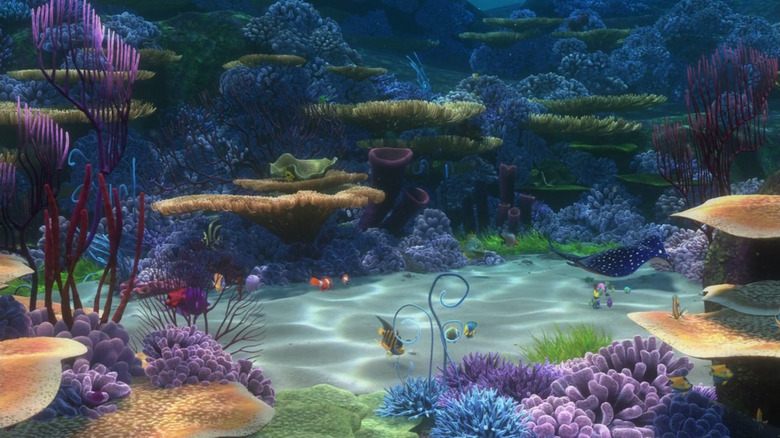The Best Movies About The Ocean, Ranked
Covering 71% of Earth's surface, the oceans provide a food source, a method of transportation and recreation, and are home to species that can only thrive below the water's surface. Some of the largest animals we know about are there, and unique ecosystems like the benthic zone exist in the darkest depths of the world's oceans. With how vast the ocean is, it's impossible for someone to explore every aspect of it, but that hasn't stopped filmmakers from making an effort to document as much as possible.
Oceans have provided ample inspiration for filmmakers over the decades: There's an ocean movie out there for everyone, no matter what genre you're looking for. Directors have taken both tragedies and uplifting stories to showcase the beauty of the water and highlight the dangers that lurk below. While there are plenty to choose from, we've compiled a list of the best ocean movies, from classic thrillers and spectacular documentaries to adaptations of books and true stories.
11. Open Water
The survival horror film "Open Water" chronicles what happens when divers Daniel and Susan are forgotten by a diving boat, leaving them alone in the ocean with no way to get back to shore. The two do their best to survive despite the conditions, which include encountering sharks, jellyfish, and the realization that the boat won't be back in time as a storm moves in. The story takes place nearly entirely in the ocean as the camera follows the couple on the water's surface.
Loosely based on the true account of Tom and Eileen Lonergan, who were left by a diving boat near the Great Barrier Reef and subsequently disappeared, "Open Water" shows the ocean from a more sinister, albeit realistic, perspective (especially because they used real sharks and not CGI or animatronics, which broke the norm for shark movies). It highlights how dangerous it can be in the water without the correct equipment and how quickly stranded people can grow dehydrated and exhausted in this unforgiving environment.
While the couple has their wet suits to fight against hypothermia and their diving equipment keeps them buoyant, they are helpless to save themselves since they don't know which direction shore is or where other boats could be, and it isn't safe to chance swimming any which way when they can't see any evidence of civilization. It's a terrifying situation handled brilliantly by the filmmakers.
- Starring: Daniel Travis, Blanchard Ryan, Michael E. Williamson
- Director: Chris Kentis
- Year: 2003
- Runtime: 1h 19m
- Rating: R
- Rotten Tomatoes Score: 71%
10. Avatar: The Way of Water
"Avatar: The Way of Water," the sequel to James Cameron's 2009 smash hit "Avatar," takes audiences back to Pandora. Jake and Neytiri settle into their lives as parents and leaders of their clan, building a life now that Jake has left his human body behind and completely become one with his Na'vi avatar. However, the military returns to the planet hoping to colonize it and establish a human population on Pandora to use its resources, just like they originally intended during the first movie.
The second "Avatar" installment highlights both the beauty and destruction of the ocean. Humans come back to Pandora to exploit the Tulkuns, a species similar to Earth's whales. These amazing animals produce a substance from a gland in their brains called Amrita, which humans discover can stop the aging process. The exploitation of the Tulkuns is juxtaposed against one of Jake's children, Lo'ak, bonding with one in a callback to the original "Avatar" film.
The two plot lines show two distinctly different relationships with the ocean: One of kindness and understanding, and another that is detrimental to its life. Though set in a fictional world, it speaks to the issues plaguing our own oceans, whaling in particular. In an email he penned after being blindsided with a dolphin show while promoting "The Way of Water" in Japan, Cameron wrote (via Yahoo!) that the sequel is "all about saving whales, and treating them with empathy as equals. It's the pivotal message of the film."
- Starring: Sam Worthington, Zoe Saldaña, Sigourney Weaver
- Director: James Cameron
- Year: 2022
- Runtime: 3h 12m
- Rating: PG-13
- Rotten Tomatoes Score: 76%
9. Oceans
"Oceans" is a nature documentary that takes audiences across our planet's diverse oceans, presenting the animals and habitats of each. From the ocean life many know, like dolphins, seals, and turtles, to the animals that aren't as familiar, like the Spanish dancer slug and the wrasse, this engrossing doc showcases many different types of marine life.
The English version of the film is narrated by former James Bond actor Pierce Brosnan, who does a wonderful job. His voice works perfectly with footage from all over the world, with this being one of the few documentaries to go to all five oceans. It allows audiences to see the diversity of each one, and the film also reinforces the negative impact of human activity on the oceans by using satellite images and videos to show the masses of trash both above and below the surface, as well as the animals that get caught as bycatch in fishing nets.
This responsible approach enables the viewers to have a picture of the issues talked about, rather than just hearing about them. While it is enchanting to watch sea turtles hatch and divers swim with sharks and whales, that's not the full picture. "Oceans" reinforces that we can only continue to explore and enjoy these magical underwater worlds if we change how we treat them.
- Starring: Jacques Perrin, Pierce Brosnan
- Director: Jacques Perrin, Jacques Cluzaud
- Year: 2009
- Runtime: 1h 24m
- Rating: G
- Rotten Tomatoes Score: 81%
8. The Deepest Breath
"The Deepest Breath" is a 2023 Netflix documentary that follows people rather than animals. The life stories of two free divers, Alessia Zecchini and Stephen Keenan, are presented side by side as Keenan helps Zecchini train to break a world record. Free diving is one of the most dangerous and extreme water-related sports because divers rely solely on their own breath and typically a monofin to propel themselves as far down as they can before having to return to the surface.
While the film focuses on the personal journeys of Zecchini and Keenan, it also shows the darkest depths of the ocean that are not included in most documentaries. Visually, "The Deepest Breath" is captivating, showing us the vastness below the surface. The divers tackle places considered incredibly perilous to dive in, like the arch in Dahab, Egypt. Through the presented footage, divers disappear into the dark before emerging again, providing a better idea of the low visibility at such depths.
The film also shows the risks of the sport, and how it sometimes ends in tragedy. "It keeps you wondering what fate will befall these intertwined figures who live seemingly to cheat death, and it manages to celebrate the depths to which they pursued their shared obsession," Rolling Stone said in its review.
- Starring: Alessia Zecchini, Stephen Keenan
- Director: Laura McGann
- Year: 2023
- Runtime: 1h 48m
- Rating: PG
- Rotten Tomatoes Score: 85%
7. The Abyss
In the sci-fi thriller film "The Abyss," a team of Navy SEALs in the Caribbean are in a race to find a sunken United States submarine before the Soviets do, all while a hurricane heads toward the location. It's another Ocean-based adventure from James Cameron, and there are many who feel that "The Abyss" is actually Cameron's best movie. In terms of the plot, there is something else lurking below that could be to blame for the submarine's sinking — and it isn't from this world. The crew ends up battling through equipment malfunction, power outages, and trying to disarm a warhead as a glowing, tentacled force settles in around the rig.
"The Abyss" is one of the best ocean features because it focuses on a working environment that still exists today. They aren't under the water like the SEALs in the movie, but people still live on drilling rigs. The film shows what work can look like on a rig in the water, how the environment around it can impact that work, and that there is plenty of life to observe on the ocean floor. While the life in question in the movie is fictional and extraterrestrial in nature, it's an example of the necessary adaptations marine life developed to live in near-dark conditions. In this case, the alien glows, providing light where the sun can't reach.
- Starring: Ed Harris, Mary Elizabeth Mastrantonio, Michael Biehn
- Director: James Cameron
- Year: 1989
- Runtime: 2h 45m
- Rating: PG-13
- Rotten Tomatoes Score: 89%
6. Life of Pi
"Life of Pi" is based on the book of the same name by Yann Martel. Pi Patel tells an author the story of how he survived a shipwreck near the Mariana Trench and made it to Mexico after over 200 days on the water. His family is moving to Canada from India, making the journey on a freight ship with the animals from the zoo they own, when a bad storm causes the ship to sink. Pi survives and ends up on a lifeboat with a tiger named Richard Parker. The two battle the elements, endure starvation, dehydration, and supply loss before landing in Mexico.
One of the most breathtaking scenes is when Pi realizes the lifeboat and raft are in a group of bioluminescent krill. The sight of the glowing green animals is beautiful, especially as a humpback whale appears to grab a meal (the CGI whale was created by the VFX company Rhythm and Hues, something only true "Life of Pi" fans know). As visually stunning as the sequence is, the whale destroys the raft, forcing Pi and the tiger into the same boat. This alters Pi's chances of survival since he and the tiger are still at odds. This Oscar-winning film showcases both the beauty and raw power of the ocean. While the destroyed raft is a byproduct of a natural phenomenon, the sequence reinforces how important every resource is when lost at sea.
- Starring: Suraj Sharma, Irrfan Khan, Tabu
- Director: Ang Lee
- Year: 2012
- Runtime: 2h 7m
- Rating: PG
- Rotten Tomatoes Score: 86%
5. 20,000 Leagues Under the Sea
Based on the classic sci-fi novel by French author Jules Verne, the film "20,000 Leagues Under the Sea" shares the tale of Captain Nemo as he navigates the oceans in his submarine, the Nautilus. Harpooner Ned Land, Professor Pierre Aronnax, and the professor's assistant Conseil stay on the submarine with Nemo after running into it while traveling on a Navy freight ship, initially mistaking the sub for the monster they're after. As they experience what life is like in the submarine, from harvesting food on the ocean floor to watching Nemo act as a vigilante on the water by destroying ships, the group does eventually come across the monster.
The movie shows a fictional life under the ocean. Nemo has created an entirely different way to live hidden away in the depths of the water, one that while not realistic, is as entertaining as it is appealing because of the way it's executed. The special effects and ocean sequences in "20,000 Leagues Under the Sea" are ahead of their time, including the battle with the actual monster, the giant squid. Production used both footage captured in the Bahamas and models to successfully create the underwater sequences. The work earned the film the awards for best special effects and best color art direction at the Academy Awards in 1955.
- Starring: James Mason, Kirk Douglas, Paul Lukas
- Director: Richard Fleischer
- Year: 1954
- Runtime: 2h 7m
- Rating: G
- Rotten Tomatoes Score: 91%
4. Titanic
The third and final James Cameron movie on this list, "Titanic" tells the love story of Rose and Jack, two passengers on the ill-fated maiden voyage of the RMS "Titanic." They're separated by class status, but the two don't let that stop them from engaging in a whirlwind romance after falling for one another. However, as the vast majority of people will be aware of going into the picture, the fancy ship hits an iceberg and sinks.
While ultimately a love story, "Titanic" also showcases the unpredictable nature of the ocean and how deadly an accident at sea can be. Even a ship that most people thought of as unsinkable can end up at the bottom of the ocean. Cameron expertly captures all the stages of the famous sinking in this best picture winner, from the initial confusion and widespread panic to the grim acceptance that set in toward the end. It's one of the most significant and well-known tragedies in history, and the film handles that in a respectful manner.
"Titanic" uses real footage of the shipwreck resting on the ocean floor (Cameron has been down to see it for himself on more than 30 occasions). It adds a nice touch of realism, and it also shows how shipwrecks can become integrated with ocean ecosystems. As the team searches for the safe in the opening sequence, fish swim through and vegetation is anchored to the structure, reminding us that new life can be supported by the remains of a human tragedy.
- Starring: Leonardo DiCaprio, Kate Winslet, Billy Zane
- Director: James Cameron
- Year: 1997
- Runtime: 3h 14m
- Rating: PG-13
- Rotten Tomatoes Score: 88%
3. Jaws
To this day, Steven Spielberg's "Jaws" is the shark movie. It centers Roy Martin, the chief of police in a summer town trying to mitigate a shark problem during the height of tourist season. The town's mayor thinks the issue is solved after a tiger shark is caught, refusing to believe that something larger could be lurking in the water despite the mounting pile of evidence to the contrary.
Other entries on this list discuss or show the exploitation and beauty of the ocean, but "Jaws" serves as a reminder that humans are nowhere near the top of the food chain when they get in the water. No matter what the group of men try, the shark nearly always manages to survive or escape capture. It reinforces that sharks are apex predators and that they should be left alone in their environment. "Jaws" also shows the importance ocean-based tourism has for small towns on the coast, an industry that isn't always shown in movies centered on the ocean.
Spielberg spent around six months shooting the film in Massachusetts with a mechanical shark. Production went 12 miles off the coast, which, as Spielberg said in an interview with Vanity Fair, was perfect to "avoid any sighting of land but still have a sandy ocean bottom only thirty feet below the surface, where we could install our shark sled." In addition to filming on location with the mechanical shark, footage of real sharks was shot in Australia and incorporated into the feature, with Spielberg even rewriting a sequence to fit the real footage.
- Starring: Richard Dreyfuss, Roy Scheider, Robert Shaw
- Director: Steven Spielberg
- Year: 1975
- Runtime: 2h 4m
- Rating: PG
- Rotten Tomatoes Score: 97%
2. My Octopus Teacher
"My Octopus Teacher" is a 2020 Netflix documentary that follows filmmaker Craig Foster's journey as a diver and father. Amazingly, Foster becomes friendly with a female octopus in the kelp forests off the coast of Cape Town, South Africa. Over the span of a year, he observes the octopus' life from all sides, from eating to resting and healing. He learns more about the balance of life as he develops a connection with animals and nature that he didn't have before.
The documentary shows the lifecycle of an octopus in intimately close detail, from monotonous to perilous: Foster watches on as his new octopus friend is attacked by a shark. The cephalopod survives but it takes several months to regrow the tentacle she lost, causing her to remain in her den during that time. She mates and lays eggs, completing the octopus lifecycle as she dies a natural death. Only then does she become a meal for a shark.
"My Octopus Teacher" reminds viewers just how beneficial our relationship with marine life can be. Foster credits the experience with helping him learn to be more than just a visitor on Earth, encouraging him to be more engaged with the other life on it. It gave him a way to connect with his son, who is interested in the ocean, and provided Foster with a new lease on life. It's a beautiful film in every possible sense of the word.
- Starring: Craig Foster
- Director: Pippa Ehrlich, James Reed
- Year: 2020
- Runtime: 1h 25m
- Rating: TV-PG
- Rotten Tomatoes Score: 93%
1. Finding Nemo
Despite the fact that it's animated, the beloved Pixar film "Finding Nemo" is hands down the best movie about the ocean. It tells the story of Marlin (voiced by Albert Brooks), a clownfish trying to rescue his son Nemo after divers capture the little fish with a malformed fin. Marlin travels across the ocean, meeting sharks, sea turtles, and a blue tang named Dory before reuniting with his son in Sydney, Australia.
"Finding Nemo" is the perfect way to experience the ocean through a fictional, relatable story of a parent going to the literal ends of the Earth to find their child. Different habitats, like a clownfish's anemone, the near total darkness closer to the deep ocean floor, and coral reefs showcase the variety of life under the sea. Marlin's encounter with a group of vegetarian sharks provides a more positive view of the species than other films — while "Jaws" is a classic, it's been accused of negatively impacting shark preservation efforts.
In addition to being a great ocean movie, "Finding Nemo" was a real game changer in terms of CGI filmmaking. The American Film Institute regards it as one of the top ten best animated films ever made, and it was also the first Pixar project to win the Academy Award for best animated feature, the start of a number of wins for the animation studio. The 2016 sequel "Finding Dory" is also a great watch that will keep adults entertained, but "Finding Nemo" may never be topped when it comes to oceanic adventure.
- Starring: Alexander Gould, Albert Brooks, Ellen DeGeneres
- Director: Andrew Stanton
- Year: 2003
- Runtime: 1h 40m
- Rating: G
- Rotten Tomatoes Score: 99%
